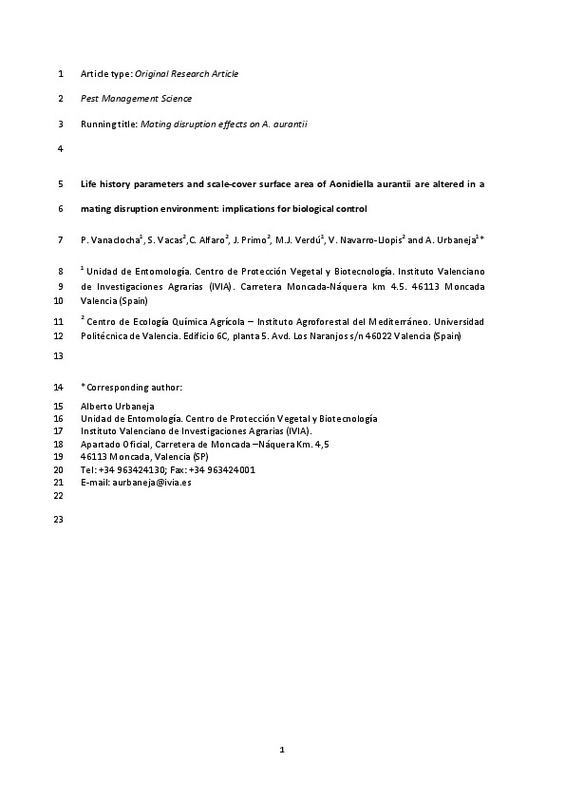JavaScript is disabled for your browser. Some features of this site may not work without it.
Buscar en RiuNet
Listar
Mi cuenta
Estadísticas
Ayuda RiuNet
Admin. UPV
Life history parameters and scale-cover surface area of Aonidiella aurantii are altered in a mating disruption environment: implications for biological control
Mostrar el registro sencillo del ítem
Ficheros en el ítem
| dc.contributor.author | Vanaclocha, Pilar
|
es_ES |
| dc.contributor.author | Vacas González, Sandra
|
es_ES |
| dc.contributor.author | Alfaro Cañamás, Cristina
|
es_ES |
| dc.contributor.author | Primo Millo, Jaime
|
es_ES |
| dc.contributor.author | Verdu, Maria J.
|
es_ES |
| dc.contributor.author | Navarro-Llopis, Vicente
|
es_ES |
| dc.contributor.author | Urbaneja, Alberto
|
es_ES |
| dc.date.accessioned | 2017-05-02T08:54:10Z | |
| dc.date.available | 2017-05-02T08:54:10Z | |
| dc.date.issued | 2012-07 | |
| dc.identifier.issn | 1526-498X | |
| dc.identifier.uri | http://hdl.handle.net/10251/80296 | |
| dc.description.abstract | BACKGROUND: In recent years, environmentally safe measures to control the California red scale (CRS), Aonidiella aurantii (Maskell), have been successfully implemented. These measures include mating disruption (MD) and biological control. The goal of this study was to examine the effect of high concentrations of the CRS sex pheromone on its life history parameters and scale-cover surface area under controlled laboratory conditions. RESULTS: The developmental time of bothmales and females of CRS increased with exposure to airborne pheromone.MD had an effect on both the total number of progeny and on the crawler production period for females. Accordingly, demographic parameters such as net fecundity (R0) and intrinsic rate of increase (rm) were significantly lower in the pheromone-treated populations. The largest scale-cover surface areas were observed in the CRS reared in the pheromone environment. CONCLUSION:Aclear influence of airborne pheromone on the biology of CRS has been demonstrated. In addition to the classical mating disruption benefits of this technique, additional benefits, such as increase in the duration of exposure to natural enemies and increase in size, which benefits some species of parasitoids, have been confirmed. | es_ES |
| dc.description.sponsorship | The authors thank H Monton, C Vidal and D Martinez for technical assistance with experiments. This work was partially funded by the Spanish Ministry of Science and Innovation (projects AGL2008-05287-C04/AGR and AGL2009-10725) and the Conselleria d'Agricultura, Pesca i Alimentacio de la Generalitat Valenciana. PV was the recipient of a grant from IVIA. Thanks also to the Ecologia y Proteccion Agricola S.L. for supplying the pheromone. | en_EN |
| dc.language | Inglés | es_ES |
| dc.publisher | Wiley | es_ES |
| dc.relation.ispartof | Pest Management Science | es_ES |
| dc.rights | Reserva de todos los derechos | es_ES |
| dc.subject | California red scale | es_ES |
| dc.subject | Reproductive parameters | es_ES |
| dc.subject | Scale-cover surface area | es_ES |
| dc.subject | Natural enemies | es_ES |
| dc.subject | Pheromone | es_ES |
| dc.subject.classification | QUIMICA ORGANICA | es_ES |
| dc.title | Life history parameters and scale-cover surface area of Aonidiella aurantii are altered in a mating disruption environment: implications for biological control | es_ES |
| dc.type | Artículo | es_ES |
| dc.identifier.doi | 10.1002/ps.3273 | |
| dc.relation.projectID | info:eu-repo/grantAgreement/MICINN//AGL2009-10725/ES/Desarrollo Y Evaluacion De La Confusion Sexual Y El Control Microbiologico Como Metodos De Lucha Contra El Piojo Rojo De California Aonidiella Aurantii Maskell/ | es_ES |
| dc.relation.projectID | info:eu-repo/grantAgreement/MICINN//AGL2008-05287-C04-01/ES/SISTEMAS DE PRODUCCION INTEGRADA EN CITRICOS: MANIPULACION DEL AGROSISTEMA PARA LA MEJORA DEL CONTROL DE PLAGAS/ | es_ES |
| dc.rights.accessRights | Abierto | es_ES |
| dc.contributor.affiliation | Universitat Politècnica de València. Instituto Agroforestal Mediterráneo - Institut Agroforestal Mediterrani | es_ES |
| dc.contributor.affiliation | Universitat Politècnica de València. Escuela Técnica Superior de Ingenieros Industriales - Escola Tècnica Superior d'Enginyers Industrials | es_ES |
| dc.description.bibliographicCitation | Vanaclocha, P.; Vacas González, S.; Alfaro Cañamás, C.; Primo Millo, J.; Verdu, MJ.; Navarro-Llopis, V.; Urbaneja, A. (2012). Life history parameters and scale-cover surface area of Aonidiella aurantii are altered in a mating disruption environment: implications for biological control. Pest Management Science. 68(7):1092-1097. doi:10.1002/ps.3273 | es_ES |
| dc.description.accrualMethod | S | es_ES |
| dc.relation.publisherversion | http://dx.doi. org/10.1002/ps.3273 | es_ES |
| dc.description.upvformatpinicio | 1092 | es_ES |
| dc.description.upvformatpfin | 1097 | es_ES |
| dc.type.version | info:eu-repo/semantics/publishedVersion | es_ES |
| dc.description.volume | 68 | es_ES |
| dc.description.issue | 7 | es_ES |
| dc.relation.senia | 234397 | es_ES |
| dc.contributor.funder | Ministerio de Ciencia e Innovación | es_ES |
| dc.contributor.funder | Institut Valencià d'Investigacions Agràries | es_ES |
| dc.contributor.funder | Generalitat Valenciana | es_ES |






![[Cerrado]](/themes/UPV/images/candado.png)


